GOLDEN FRUIT
How I learnt to love a golden kiwi
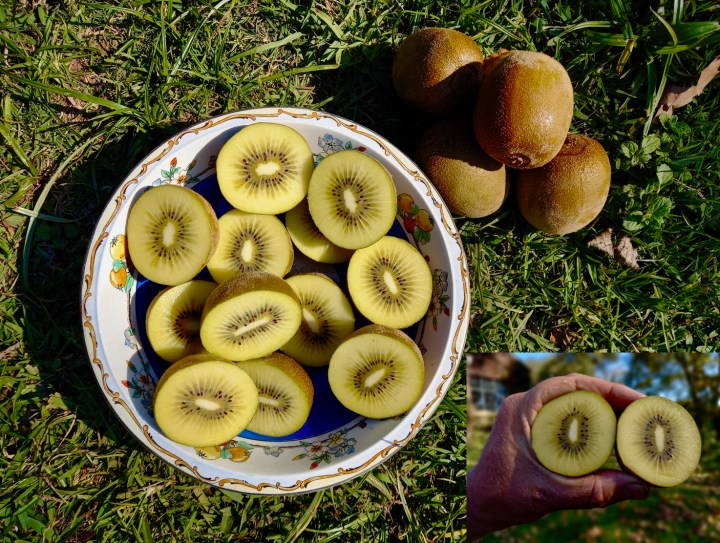
Kiwifruit. Named for the New Zealand kiwi bird but not native to that country. Meet Richmond farmer Peter Nicholson, a champion for SA’s emergent golden kiwi market. Better still, eat a gold kiwi.
It was on. It was off. It was on again. Floods. Washaways. Missed messages. Then, with the stops and stars finally aligned, it almost didn’t happen. That time, who would have thought in this day and age: a connectivity glitch. But now, here we are. To meet, or better still, to eat the golden kiwi. Perhaps you’re familiar with it? I wasn’t before my initial contact with Richmond farmer, Peter Nicholson, whose passion for the ambrosial fruit, which he asserts we will soon be eating in abundance, occasioned this story.
Nicholson is waiting to peel, slice and feed me perfectly ripe golden kiwis when I arrive almost three hours late (will revert to printing directions going forward) at what started life as one of the original homesteads of the Byrne settlers who came from Yorkshire in 1850. He is a fifth-generation farmer in the Hella-Hella area outside Richmond on a farm that has belonged to the same Nicholson family for more than 160 years. It is one of those rambling genteel old farmhouses with little secret gardens you stumble upon filled with tumbling flowering shrubs.
I had eaten my fair share of kiwifruit before meeting up with him. And had known about kiwifruit since a distant-memory marketing campaign told us the kiwis were coming, as in being planted by South African farmers and we’d all soon be eating locally grown versions of what I assumed were a fruit from New Zealand. Nicholson fills in the details. That back around 1983, about 45 farmers in different parts of South Africa planted kiwifruit. These were green kiwis. They all came onto the market at the same time. Consumers (people like me) didn’t know much about them. So they didn’t sell.
“New Zealand went through the same growing pains,” says Nicholson. “But the New Zealand government realised the potential of the fruit and subsidised kiwi producers. They came out of the dip and today have the third biggest industry in global terms of area.” After China. Then Italy, “which has more hectares under production but New Zealand’s yields are higher”.
Back in the ’80s after that failed growing and marketing attempt, most farmers here in South Africa gave up.
But not his dad, who now lives in a retirement community in Howick. “He kept going with the green kiwis. But they never shot the lights out,” says Nicholson, an amusing, colourful, charismatic, comfortable-in-his-skin kind of fellow who you get a sense solves problems and makes things happen using a conciliatory and prudent, not a shoot-the-lights-out, approach. Resilient? Goes without saying. This must surely be a number one quality for a farmer.
“My dad just kept growing green kiwis as a bit of diversity on the farm,” which also had timber, cattle and starting some 20 years ago, an outdoor adventure centre, which continues and there was a school group in residence when I was there.
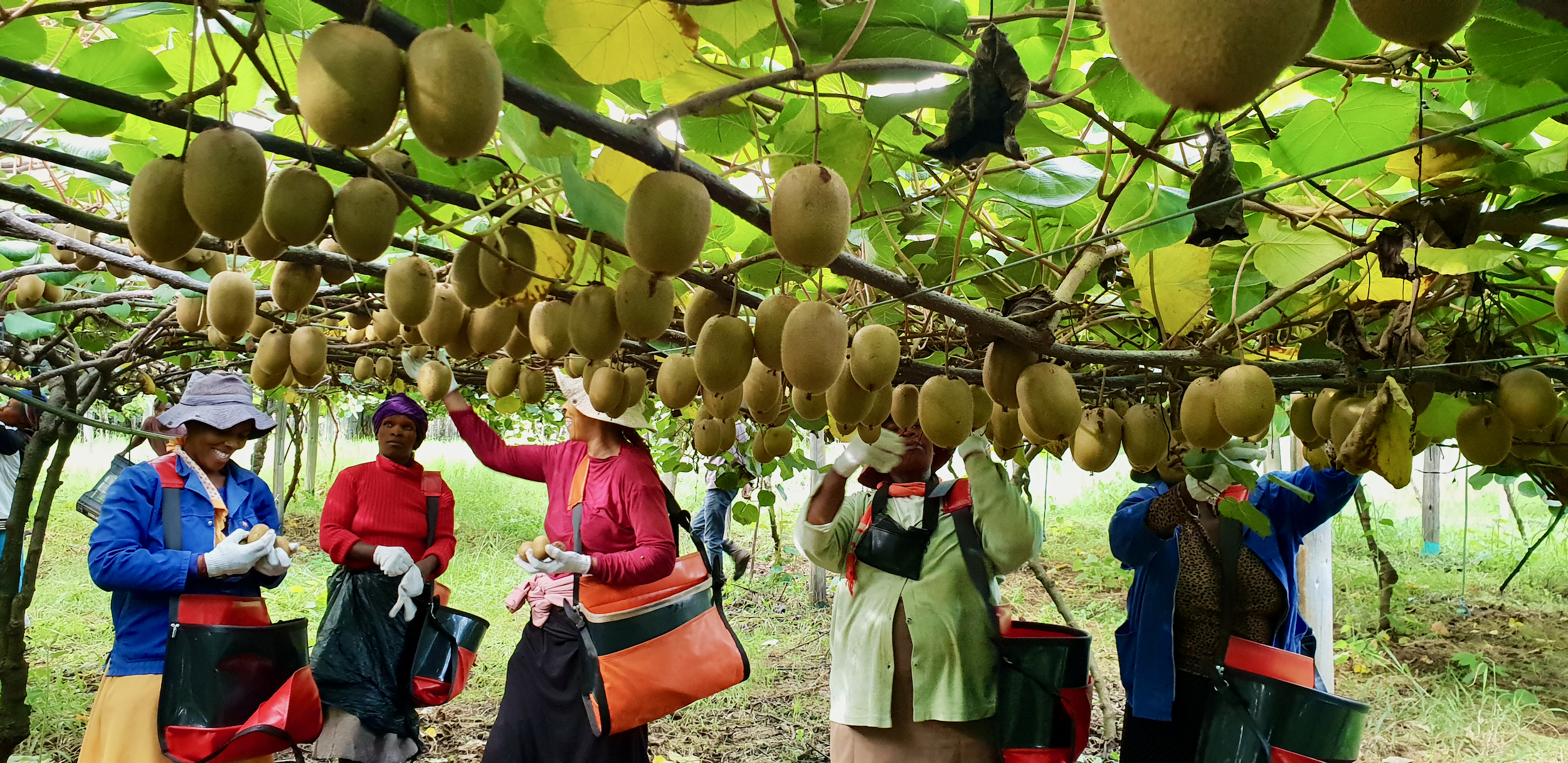
Women harvest gold kiwifruit at Roselands Farm near Richmond in KZN. (Photo: Supplied)
So, to elucidate. Those unsuccessfully introduced back in the 1980s were green kiwifruit. Botanical name actinidia deliciosa. The botanical name for the gold kiwi is actinidia chinensis. Unlike the rose, the kiwi might be a kiwi by any name, but not all taste as sweet. If you’ve not been bowled over by kiwifruit and decided the hype was nonsense, most likely you’ve only known green kiwis. As a friend who makes decadent desserts commented: “They’re great for decoration but I find them a little too tart and acidic to go nuts over.”
The gold, believe me, is something different altogether. Luscious. Sensual. Kind of pleasantly tangy tropical melon. These words come to mind to describe a perfectly ripe and peeled golden kiwi.
I say peeled, because gold kiwis are less fuzzy than green kiwis and in several articles encouraged me to eat the skin. For skin-on, we’re advised to wash the fruit in a mild vinegar solution before eating. So I tried, having found a bottle of red wine vinegar in my kitchen.
Palatable indeed, but the little jacket was more fine parchment than rice paper and did detract from the succulent juiciness of the golden orbs, an apt description when they’re fully ripe and skin off, which is what I have come to think of as the essential nature of a perfect ready-to-eat gold kiwi. Yes, you guessed, I am a fan.
For inspiration it’s worth exploring what you can do with golden kiwis. For instance, I came across ideas for a winter salad featuring blood orange, kiwi, mint, a drizzle of honey and a dash of flaky sea salt; a summertime salad with leafy green, pecans and kiwi, the dressing “hinting” of lemon; a cardamom and toasted coconut kiwi crumble topped with vanilla ice cream. Google images of “pastries with golden kiwi” for a hit of food porn. While you’re at it, check out images for red kiwis. Nicholson showed me pictures on his phone of some of these, which he reckons are also in our future.
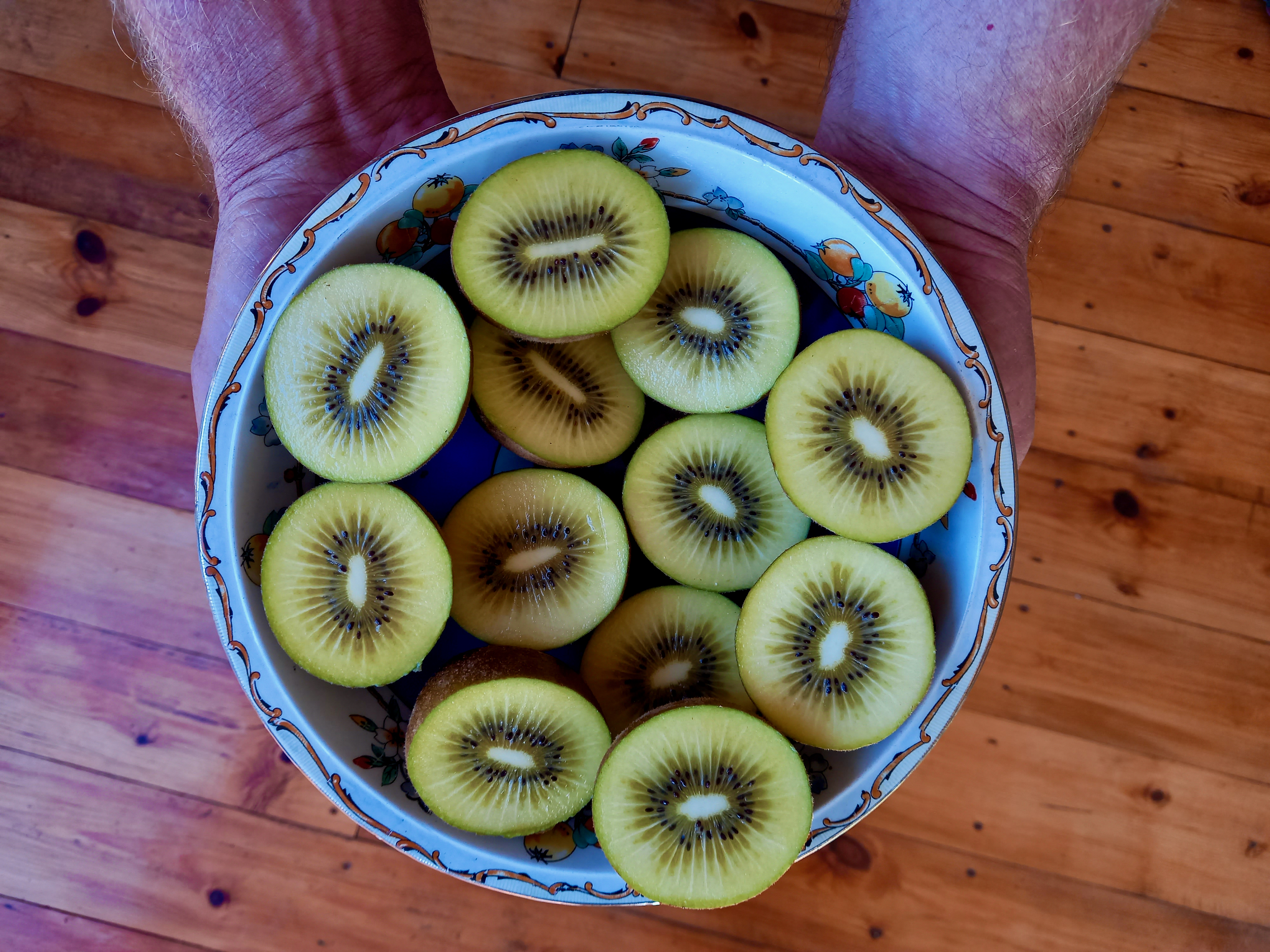
Holding out hope and gold kiwifruit. (Photo: Wanda Hennig)
Among many things learnt since making a start on this article is that the kiwifruit is native to central and eastern China, where it went by the name yang tao. A New Zealand school principal took seeds back home from China in 1904 and planted them.
When they grew, they were given the nickname “Chinese gooseberry”. Then in 1959, it not being a gooseberry, a decision was taken to change the name to kiwifruit (read the story here), the name inspired by the similarity, looks-wise, of the fruit to their national bird, the Kiwi. Read a more detailed version of this marketing strategy here.
Wikipedia, in a pithy kiwifruit 101, tells us the genus comprises around 60 species. That the fruits are quite variable, although most are easily recognised as kiwifruit because of their appearance and shape. The skin can differ in texture, hairiness and colour. The flesh varies in colour, juiciness, texture and taste.
Traditionally in China, kiwifruit was collected from the wild and consumed for medicinal purposes. Although now China is the biggest producer of kiwifruit worldwide, with almost all the fruit consumed locally.
And four decades after green kiwi production failed in this country, Nicholson and what I gather to be a small robust group of like-minded farmers are committed to turning gold kiwis into a South African success story.
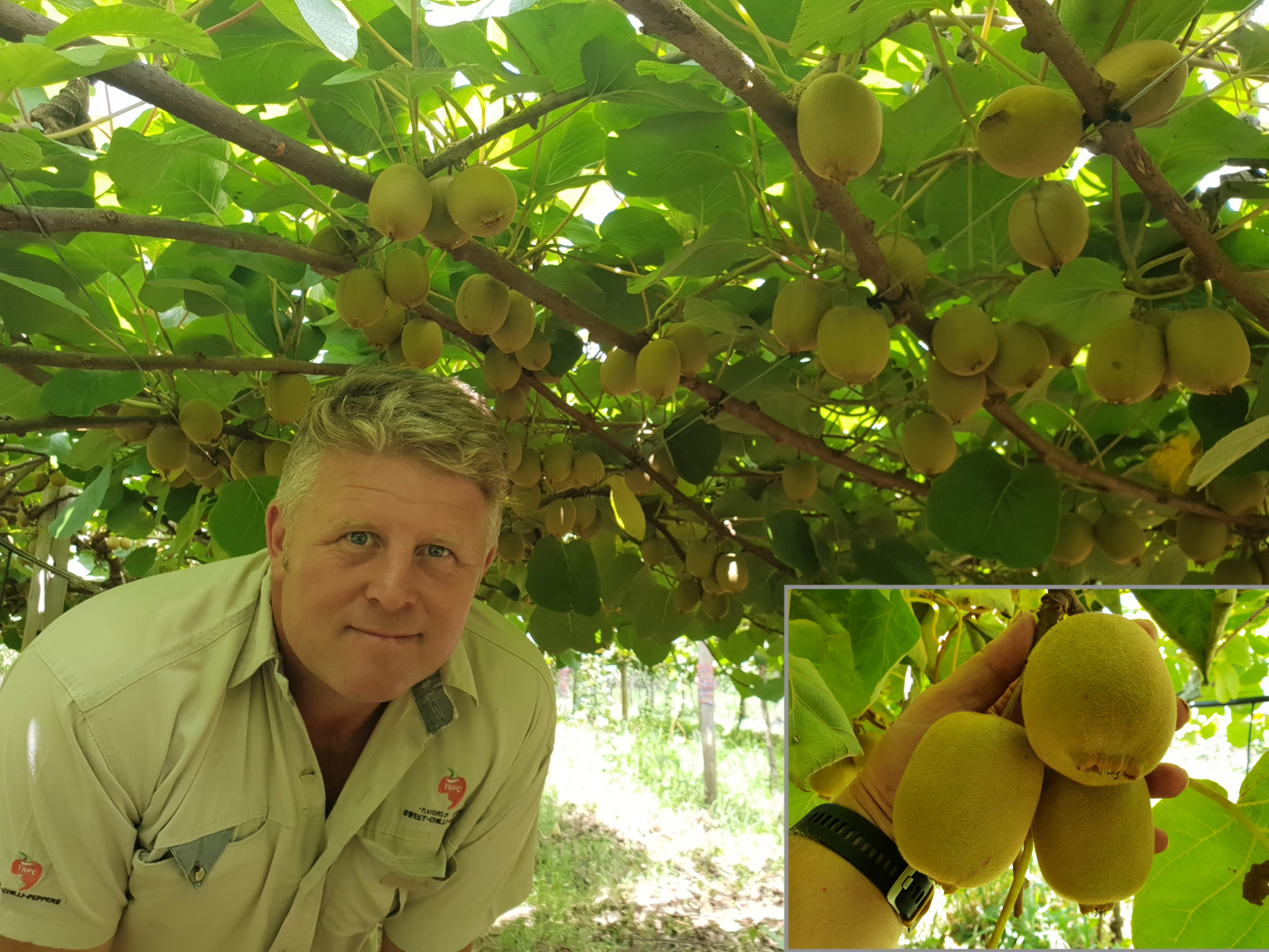
Peter Nicholson and an arcade of gold kiwis during harvest. Inset: Ready to pluck. (Photo: Supplied)
Nicholson grew up on the farm where we sit and drink decent brewed coffee after my baptism by golden kiwi. After matriculating at Maritzburg College he went to Stellenbosch University, did a BSc, then after a stint as “a jeep jockey” first at Phinda game reserve in KZN, then at Mala Mala in Mpumalanga, he went overseas for five years. Worked in London, then “blew the money” he’d earned and saved there on a fly-fishing trip “around the world… coastal states of the US, Central and South America, Canada, Belize, three months in New Zealand. I grew up fishing. If there’s a fish, any fish, I’ll try and catch it.”
He returned “and started farming here in 2005. In 2010 the first golden kiwis came to South Africa. We saw the potential and that’s when we started farming them”.
It wasn’t a walk in the pasture. “We were pioneering. Mistakes were made. Lessons were learnt.” A conman from Australia was involved, he says. Money was paid – and lost. The wrong rootstock was used. The gold were way more technical to grow than the green, he says. “We paid very painful school fees here in South Africa.”
But now, “on the upside, we own the intellectual property on two varieties. It’s a very exciting space to be in”.
Most fruit these days, he says, is grown under licence. “All the new varieties are owned by people. You enter into a contract with the owners. You pay royalties, generally, linked to fruit productivity.” Gold kiwifruit are all protected under intellectual property law, he says. “There are no open varieties available and so the number of hectares planted will always be limited.”
Reading backgrounder articles on some of this, the business and politics of fruit, brought up (yup) the words “indigestible fruit salad”. For those keen to read some of the ins and outs, perhaps potential golden kiwi farmers or just those interested in the nitty-gritty, read this story and this one, both from Farmer’s Weekly, both quoting Nicholson.
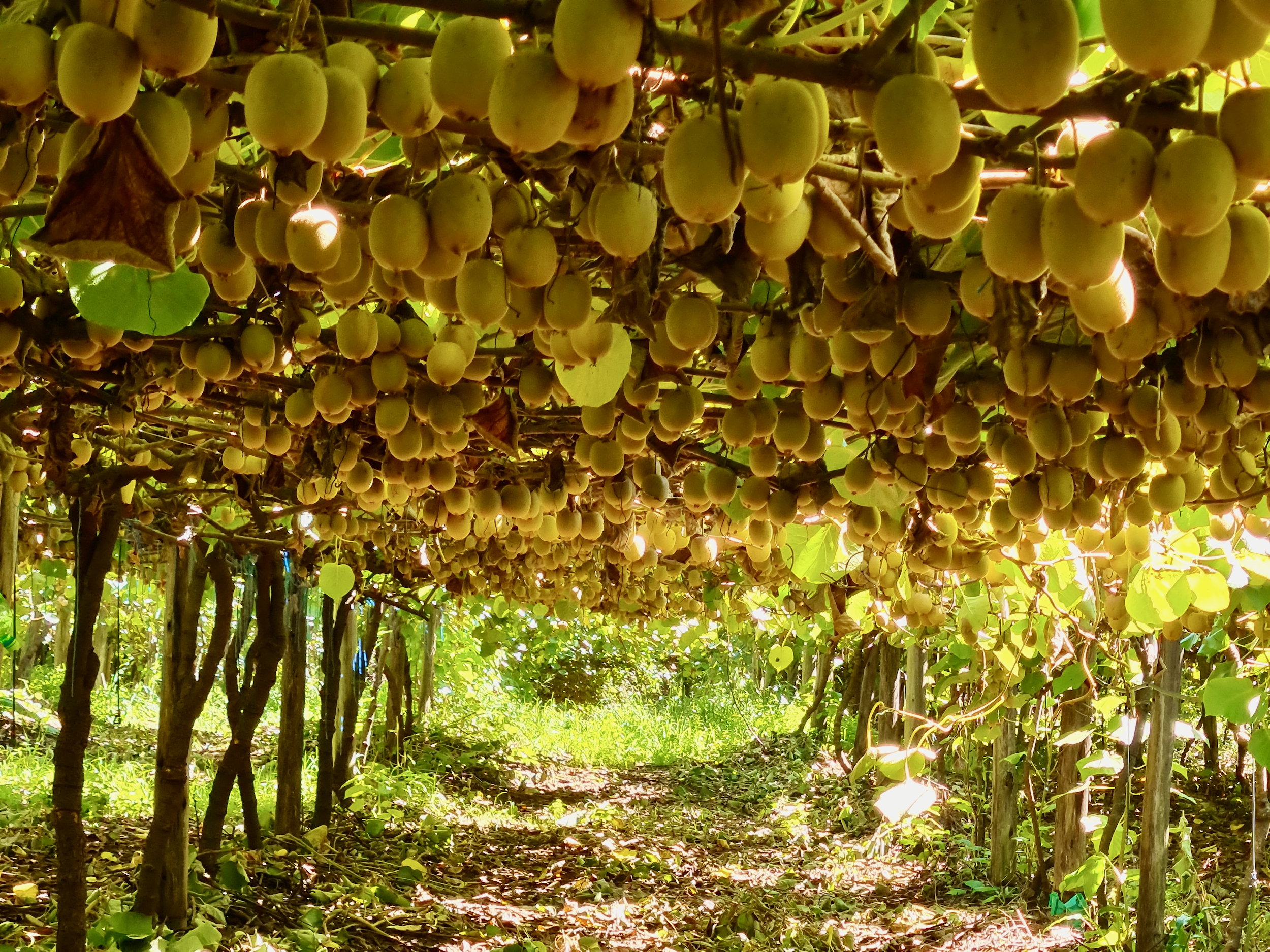
An arcade of golden light and golden kiwis, nature’s bounty. (Photo: Supplied)
Nicholson predicts that in the next decade we’ll all be eating golden kiwis. If we can afford them as it seems they will never be a cheap buy. But they are easy to grow organically and gaining popularity internationally among foodies and the health-conscious as a super fruit.
“Ninety percent of our health issues are related to how things are grown,” he remarks as we walk among the vines and trellises of what he calls the kiwi arcade, telling me how he’s been able to incorporate regenerative farming practices in his orchards. Between the framework he has planted diverse cover crops. In the winter months he raises weaner calves on these crops.
“Farming today is so often a giant cheap and nasty shortcut. Producing food as cheaply as possible. Farmers getting the raw end of the deal. The only way to produce cheaply is with what is being sprayed and genetically modified. The poisons they spray beg belief.” One of the reasons he is so taken by kiwi production is the fact that they require minimal fungicides or pesticides.
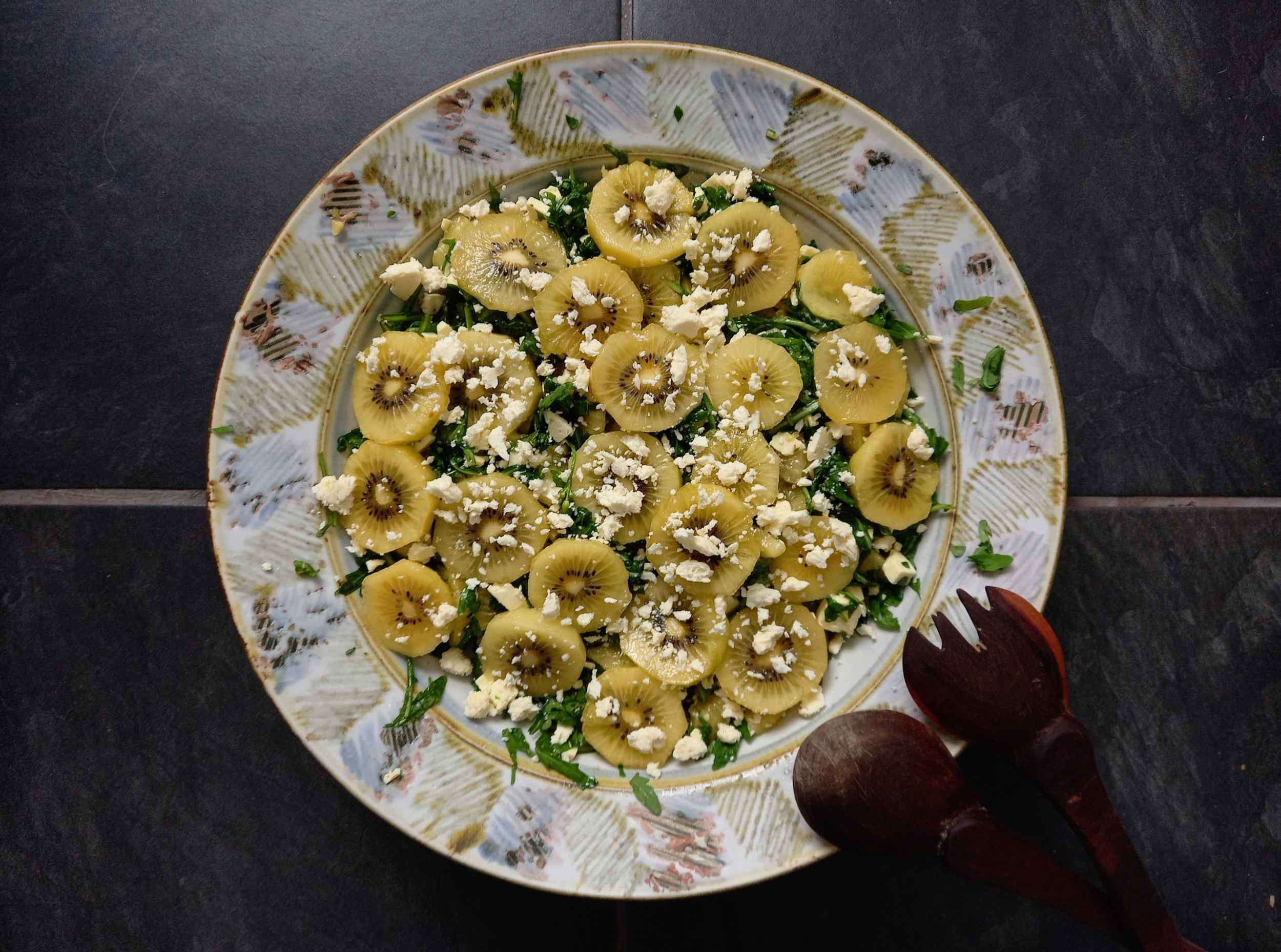
A golden kiwifruit salad with rocket, feta and other things tasty. (Photo: Wanda Hennig)
When I’m about to leave Roselands Farm, Nicholson brings me a recyclable shopping bag of golden kiwis. He tells me they will keep well for some weeks if I take them home and refrigerate them. When I want to eat from my stash, I should leave the desired number out of the fridge to ripen over four or five days. When ripe, he says, the surface will “give” slightly when pressed. “Like a mango does,” I read elsewhere.
Only when I get home do I remember that this is Friday and I’ve been asked by a friend to bring a salad to a lunch party on Sunday.
Grand idea. A golden kiwi salad. But frantic panic. How to use them when they are not ripe? I message Nicholson. Help!
“What you can do is put them in a sealed bag with a banana or an apple,” he messages back. “That will speed up the ripening process. Leave them at room temperature and I’m pretty certain some of them will be ready by Sunday. Basically what happens, the bananas and the apples emit ethylene gas (the so-called fruit ripening hormone), which dramatically speeds up the ripening of the kiwis.”
I have an apple and a banana so I do what he says with this double measure. And sure enough. It works. Rocket, feta, a few twists of smoked Oryx desert salt, slivers of red onion, herbs and spices – and golden kiwis. And there you have it. We’re all eating gold kiwis already. And by the way, the next time I go to Woolies after my farm visit, there among the fruit in the fridge section I spot a little box of them. Gold kiwis.
Back to that on again, off again and the connectivity glitch that accounted for my better late than never arrival at Roselands. My plan was to do what Nicholson had suggested and Google “maps” on my cellphone for the directions from Richmond to the farm.
Not imagining, on this very day at 5am, Vodacom will go dark in Richmond and only power up again around the time I stop to buy cabbages from a farm stall before my drive home. So no map, no cellphone connection, no WhatsApp. No clue where to go.
Finally, help comes from the sole person sitting in a shisanyama, who refers me to a very elderly Mrs Adam, confined to her house and a walker by a broken hip, a security guard she summons on a little unsmart cellphone to help the “lost white lady”, a teacher who had once done a course at Roselands and finally, a copy shop assistant in the Richmond labour court building who tells me not to chance the drive to the farm for fear of potholes and ruining the car. But who knows the way and gives me directions.
Oh yes, life happens when you’re busy making other plans. And gives you food for thought. And fodder for a different kind of story. DM/TGIFood
Contact Peter Nicholson at [email protected].
Follow Wanda on Instagram wanda_hennig





 Become an Insider
Become an Insider
Comments - Please login in order to comment.